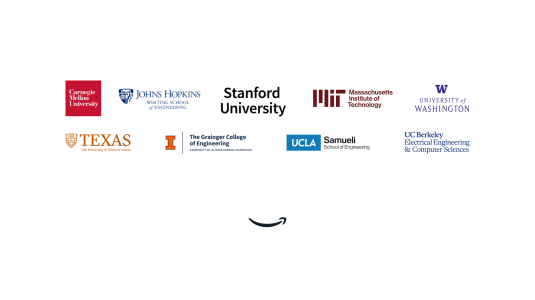COVID-19 has caused massive disruption around the globe. That includes the myriad of science conferences held each year. With the pandemic now forcing the cancellation of nearly all in-person events, these conferences have gone virtual.
Amazon is a participant in this trend. In late September, for instance, Amazon’s consumer science organization held its seventh annual Consumer Science Summit, which focused on science applications for economic decision-making, with topics ranging from operations research and econometrics, to statistics and machine learning. Originally planned as a 200-person conference to be held at a resort in Washington state, event organizers considered how best to proceed. Their final decision: move the summit online.
No one was sure quite what to expect, but the outcome was surprisingly positive. Without the need to limit attendees due to space constraints, and without the need for participants to build travel days into their schedule or worry about acquiring a US visa, attendance was more than four times that of previous in-person events. Moreover, prominent scientists who otherwise might have been unable to attend in person were able to deliver virtual keynote talks.

“In this age of isolation and uncertainty, it turns out this event helped us return to the roots of science — the exchange of ideas,” said Ping Xu, forecasting science director within Amazon’s Supply Chain Optimization Technologies organization.
In fact, scientists everywhere are discovering that a well-run virtual event can have benefits that extend beyond an in-person conference.
The Scientist magazine, for instance, reported on an August conference held by the Society for Mathematical Biology and the European Society for Mathematical and Theoretical Biology. Originally set for Heidelberg, Germany, the virtual conference created virtual space so it would provide for socializing, networking, and mentoring, as well as hearing talks, seeing posters, and visiting the meeting’s corporate sponsors.
Plus, the roughly 1,800 attendees represented more than 90 countries — two to three times as many as at previous in-person meetings.
The move to virtual scientific conferences poses some intriguing questions. Will it make science more collaborative and multidisciplinary? Or will people lose the chance for serendipitous connections that are the staple of in-person event?
In an effort to make up for the lack of in-person interaction, Consumer Science Summit organizers took advantage of online tools to facilitate collaboration among virtual attendees. The conference had its own Slack channel, for instance, and networking coffee breaks occurred over Chime. The four-day conference included the presentation of 208 papers and abstracts, 5 keynote, 28 lightning, and 12 technical talks, and 2 fireside chats.
The keynote talks included presentations by Ming Lin, a computer science professor at the University of Maryland; Anna Nagurney, the John F. Smith Memorial Professor within the Department of Operations and Information Management at the University of Massachusetts Amherst Isenberg School of Management; Susan Athey, an economics of technology professor at Stanford University, and senior fellow of the Stanford Institute for Economic Policy Research; Nassim Taleb, distinguished professor of risk engineering at the NYU Tandon School of Engineering, and author of several books, including “The Black Swan”; and Gerard Cachon, a professor within the Operations, Information and Decisions Department at the University of Pennsylvania Wharton School. The two fireside chats were with Scott Aronson, the David J. Bruton Centennial Professor of Computer Science at the University of Texas at Austin, and Swami Sivasubramanian, vice president, AWS machine learning. Below are three of those keynote talks.
“It was much better than I expected, given my first exposure to the technology that we would rely upon,” says Robert Stine, senior principal scientist within SCOT. “Some aspects, such as the recorded lightning talks worked very well. This format was better than the awkward in-person version — and could be combined nicely with online meetings and poster sessions.”
Adds Mauricio Resende, a principal scientist within Amazon’s Transportation Services organization: “I attended the previous four summits, and was pleasantly surprised at how well this virtual conference ran. We had a few glitches where people had to refresh their browsers, but otherwise there were no delays, no problems with the live presentations — or the recorded ones. And we had a much larger audience.”
Ping Xu, the event’s sponsor, agrees.
“I thought it went really well,” she says. “I was really glad to see that we could draw a wider audience by going virtual. Plus, we learned a lot about how to manage a virtual conference. For instance, one thing I learned is that the virtual format encourages a broader engagement but an in-person format encourages a deeper engagement. For our 2021 conference, we are entertaining a hybrid approach where we can offer online talks for a larger audience but still allow in-person celebrations and discussions.
It was hard at times not to miss the more social aspects of an in-person conference, where scientists can connect with peers they’ve worked with before and perhaps make new connections.
“I still prefer in-person conferences,” says Resende. “They give me a chance to bump into old friends and make new ones. I have begun many a collaboration or paper on the basis of unexpected meetings at conferences.”
In this age of isolation and uncertainty, it turns out this event helped us return to the roots of science – the exchange of ideas
Some event organizers are aware of that shortcoming and have developed clever ways to address it. One conference, for instance, asked participants to write a short description of their work and research interests. That information was then run through an algorithm that matched up attendees with similar interests.
Prior to the COVID-19 pandemic, there already was a movement within the machine learning science community to allow remote paper and poster presentations at scientific conferences.
Turing Award winner Joshua Bengio is a supporter of the movement allowing more virtual presentations of papers and poster sessions, saying in a blog post that he believes “we should rethink these events with the objective of eliminating the resulting carbon footprint.”
In the post, Bengio suggests the science community could consider decentralized conferences, where instead of having a conference at one location, meeting places could be established — at least one on each continent — so that scientists could attend their “local” meeting.
Some think scientists working remotely more often would have greater impact than having science conferences adopt a completely remote model.
“I think the impact of working virtually reduces carbon footprint more than the impact of going from an in-person conference model to a virtual model,” says Resende. “I have worked remotely two or three days a week since 1988. Virtual conferencing reduces the need to see people face-to-face, but doesn’t eliminate it.”
Other drawbacks include sometimes having too much to choose from, reducing focus. And virtual conference-goers have the same challenge as remote workers everywhere: giving full attention to a conference speaker when emails are coming in and phones are ringing.
Nonetheless, most scientists expect to be attending more virtual conferences in the foreseeable future, if largely because of COVID-19.
On the plus side, a world of virtual conferences will improve as conference organizers grow accustomed to virtual formats, and new conferencing tools become available. Events are apt to draw more people — as the Amazon summit did — and can take advantage of a wider pool of speakers.
But will that improve science?
“Perhaps,” says Stine. “But there already are lots of ways to exchange ideas virtually, such as ArXiv for sharing manuscripts. And universities now post lectures and seminars on-line. That all might change, of course, with a new generation of scientists who have grown up on virtual campuses.”
No matter if in-person or virtual, the key is the exchange of ideas. In opening the Consumer Science Summit, Xu, the forecasting science director who helped organize the consumer summit, quoted George Bernard Shaw.
“If you have an apple and I have an apple and we exchange these apples, then you and I will each have an apple. But if you have an idea and I have an idea and we exchange these ideas, then each of us will have two ideas.”
Whether virtual or in-person, the primary purpose of science conferences remains the same: the exchange of ideas as researchers stand on the shoulders of the giants who preceded them, seeking to advance the science.

















